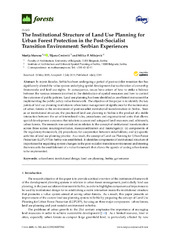Приказ основних података о документу
The Institutional Structure of Land Use Planning for Urban Forest Protection in the Post-Socialist Transition Environment: Serbian Experiences
| dc.creator | Maruna, Marija | |
| dc.creator | Crnčević, Tijana | |
| dc.creator | Milojević, Milica | |
| dc.date.accessioned | 2020-11-27T11:23:07Z | |
| dc.date.available | 2020-11-27T11:23:07Z | |
| dc.date.issued | 2019 | |
| dc.identifier.issn | 1999-4907 | |
| dc.identifier.uri | https://raumplan.iaus.ac.rs/handle/123456789/571 | |
| dc.description.abstract | In recent decades, Serbia has been undergoing a period of post-socialist transition that has significantly altered the value system underlying spatial development due to alteration of ownership frameworks and land use rights. In consequence, issues have arisen of how to strike a balance between the various interests involved in the distribution of spatial resources and how to control the outcomes of public policies. Land use planning has been identified as an efficient instrument for implementing the public policy value framework. The objective of this paper is to identify the key points of land use planning in relation to urban forest management of significance for the maintenance of urban forests in the environment of post-socialist institutional transformation in Serbia. Seen as an institutional structure, the practice of land use planning in Serbia is the product of a stable interaction between the set of interrelated rules, procedures and organisational units that allows spatial development outcomes that take into account and safeguard land resources and, ultimately, urban forests. The research was carried out in relation to the concept of institutional transformation across three scales: macro/governance, meso/coordination and micro/agency: (a) components of the regulatory framework; (b) procedures for cooperation between stakeholders; and (c) specific activities of land use planning practice. As a result, the concept of Land use Planning for Urban Forest Protection (LUPUFP) in Serbia was established. It identifies components of institutional structure of importance for regulating system changes in the post-socialist transition environment and steering them towards the establishment of a value framework that allows the agenda of saving urban forests to be implemented. | en |
| dc.language.iso | en | sr |
| dc.publisher | MDPI | sr |
| dc.relation | info:eu-repo/grantAgreement/MESTD/Technological Development (TD or TR)/36035/RS// | sr |
| dc.relation | info:eu-repo/grantAgreement/MESTD/Integrated and Interdisciplinary Research (IIR or III)/43007/RS// | sr |
| dc.rights | openAccess | sr |
| dc.rights.uri | https://creativecommons.org/licenses/by-sa/4.0/ | |
| dc.source | Forests | sr |
| dc.subject | urban forest | sr |
| dc.subject | institutional design | sr |
| dc.subject | land use planning | sr |
| dc.subject | Serbia | sr |
| dc.subject | governance | sr |
| dc.title | The Institutional Structure of Land Use Planning for Urban Forest Protection in the Post-Socialist Transition Environment: Serbian Experiences | en |
| dc.type | article | sr |
| dc.rights.license | BY-SA | sr |
| dcterms.abstract | Милојевић, Милица; Маруна, Марија; Црнчевић, Тијана; | |
| dc.citation.volume | 10 | |
| dc.citation.issue | 7 | |
| dc.citation.spage | 560 | |
| dc.citation.rank | M21 | |
| dc.identifier.wos | 000482080800002 | |
| dc.identifier.doi | 10.3390/f10070560 | |
| dc.identifier.scopus | 2-s2.0-85068545318 | |
| dc.identifier.fulltext | https://raumplan.iaus.ac.rs/bitstream/id/2480/forests-10-00560-v3.pdf | |
| dc.type.version | publishedVersion | sr |

